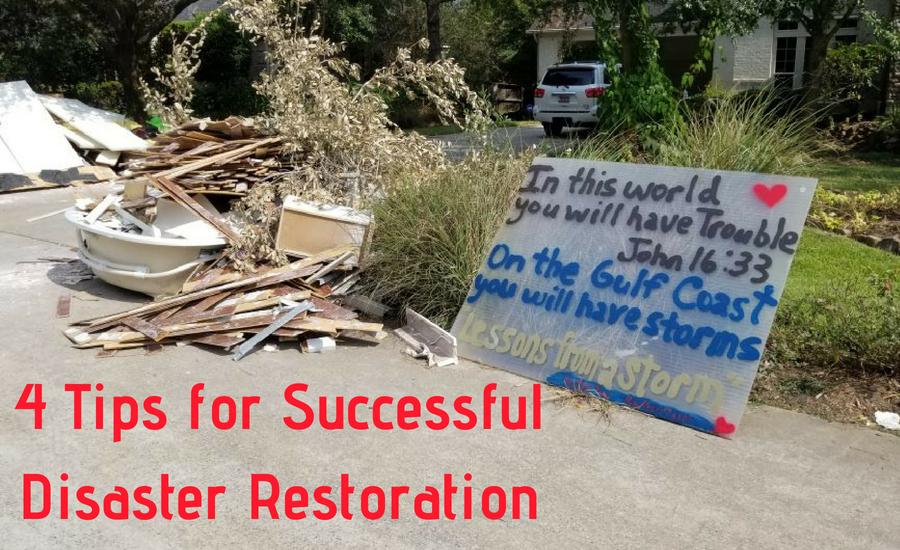4 Tips for Successful Disaster Cleaning
Article written by Jeff Heyd
Tips from a seasoned restoration industry pro on profitability, liability, education, and more.
Over the years, I’ve involved with a fair number of regional disasters such as massive flooding and hurricanes. I’ve also spent some time with those who do large loss and CAT work, so I’ve picked up a trick or two along the way. In this article, I will share some of these tips in the hopes you will find them helpful.
I believe R David Sweet of NextGen Restoration in Florida said it best in framing the first piece of advice this way, “What people beg you to do during the height of the disaster. They will often sue you for later.” He also said, “One of the biggest mistakes people make in disasters is that they forget the disaster will no longer exist when it comes time to get paid.”
Let’s break down what that means. Amidst all the urgency and chaos of disasters, property owners will beg you to cut corners. And do (or not do) things that you normally wouldn’t consider. Soon enough the disaster and its urgency will fade, and you will be judged in light of normal accepted protocol (the IICRC S500 for example). The point? Be sure you perform the work and document everything as completely as you would on any job no matter what the circumstances!
This is not to say that you should handle disaster jobs in the exact same way you would during normal times. You will need to find ways to speed things up and become much more efficient. Here are some tips to consider:
1. Triage, Triage, Triage. Some might call it “cherry-picking” and maybe it is, but during a disaster, you owe it to yourself and to the community to do as many jobs as you can successfully complete and get paid for. To do that, you will need to NOT do the ones that are going to cause you trouble or not pay. You are hurting others by wasting time with people who are going to consume more than their fair share of time and trouble.
2. Learn how to efficiently set-up jobs. Try to get a group of affected homes or businesses that are clustered in the same neighborhood. It’s likely more efficient and cost-effective to provide service to 10 properties within five minutes of each other. Then to do the same number of slightly larger properties that are located across town.
3. Spread out your talent. Team each of your certified technicians with general laborers. Technicians shouldn’t be wasting their time hauling dehus out of the truck or any other unspecialized tasks. Have your more qualified lead techs out locking down jobs and supervising the teams.
4. Put your company into “disaster mode.” Hire temps to wash equipment and load trucks. Get volunteers to make boxed lunches. Split the staff into day and evening shifts. There are a number of things you can do to improve the number of jobs you can turn in successfully if you rethink things. It’s not about cutting corners… it’s about doing what it takes to get it all done!
Another excellent piece of advice comes from Danny Strong of Disaster Restoration Services, LLC in Connecticut: “Don’t leave fish to find fish. I left lots in Texas abruptly to service Florida and would never do that again. If you have the work, stay and keep turning it!”
This advice applies both to running to different disasters as well as to running around to different parts of the same disaster. You will always hear stories about work to be had in other areas… if your area hasn’t been tapped out, maximize your efficiency by staying put.
Also, it’s good to realize commercial work is the best work during disasters. Why? Because businesses are usually easier to get paid from, there’s generally more efficient square footage involved. And there are urgency and insurance for getting the business back up and running. If you’re local, focus on making sure all the businesses in your area know who you are. And better yet, signed up for your “disaster mitigation program!”
Finally, get familiar with newer more efficient equipment, tools, and products. For example, Concrobium® Mold Control resists mold growth without toxicity or annoying scent. It’s a great tool for initial treatment and stabilization of certain jobs as well as a final treatment that makes sense. The new Concrobium® Mold Stain Remover RTU can restore the pre-loss appearance of surfaces. That has been mold stained, and Concrobium® Odor and Moisture Control Desiccant Packs and be deployed to specific areas to mitigate or prevent odor and moisture issues. During flooding and hurricane disasters, a lot of antimicrobials are used, and for good reason. The new Concrobium® Broad Spectrum Disinfectant II brings maximum Tuberculocide killing power with lighter scent, better cleaning power, lowest toxicity, …and the lowest price!

